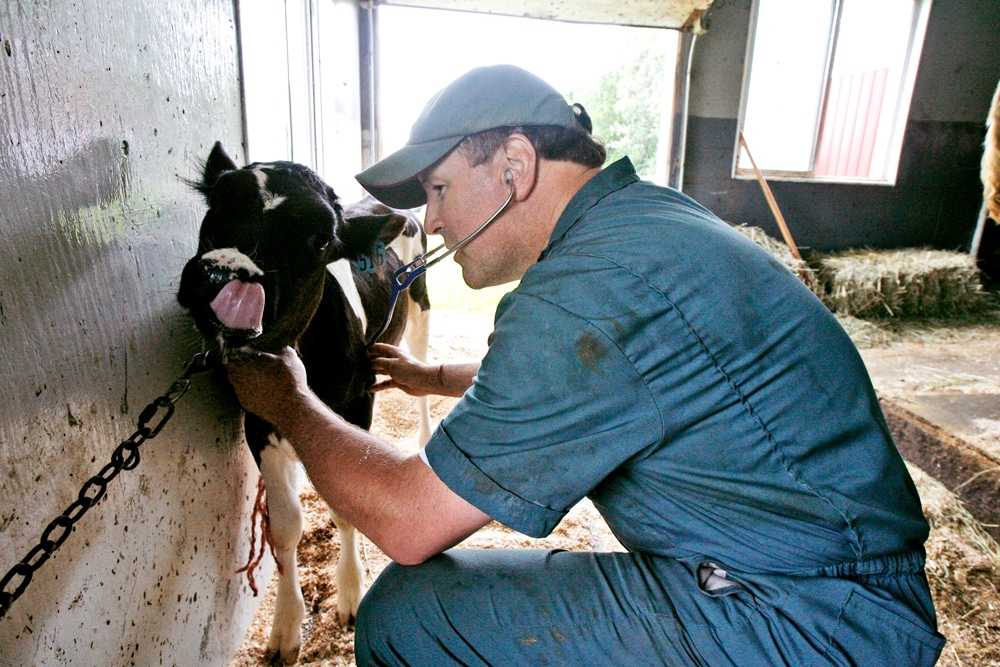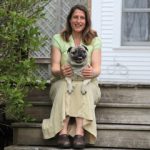The Good Doctor | The Farmer’s Life: Dispatches from Chickadee Farm in Craftsbury, Vermont
When a chef came up with a creative plan for a farm’s head boar, there was only one veterinarian willing to step up to the job.

Coffee By Design | Portland, Maine
Photo Credit : Katherine KeenanIt’s April 2017 when I get an email: Hey Julia, We’re pondering pasturing a couple hundred pigs in the field below your place this summer. Any problems with that idea? Pete.
Well hey, Pete, I’d prefer your plentiful pigs were put in another province, I might have replied. Instead, I pretended to be delighted. So, from May to October, I became their neighbor, watching them loaf and scamper, hearing them squeal and grunt through the night.
Traditionally, pigs are reared in a dedicated single area, which they progressively degrade, rooting through soil, turning vegetation to mud. On large-scale commercial hog operations, animals can spend their whole lives inside a barn. Pete’s pigs, however, had plenty of fresh air, sunlight, and movable metal shanties for shelter and shade.

Photo Credit : Toby Talbot/AP Photo
Every day these pigs greeted Torrey, the pig manager, with unruly enthusiasm, snorting and surging toward his maroon pickup truck. Twice a week, Torrey would hitch his truck to the shanties and tow them to a fresh parcel of field. Predictably, the pigs would rush after him to reach new grasses and clovers. In between these shanty relocations, Torrey hauled around a huge plastic tank filled with whey, a milky slurry, which was a by-product of a local cheese-making operation. Torrey attached a hose to the tank and channeled the whey straight into the shallow troughs, where the pigs clamored to drink. A few times, I pedaled my bicycle down to the field to watch them swill, whereupon the pigs would trot over to me, the newcomer, and with their moist noses they’d snuffle my sneakers and probe my bare legs. They seemed only curious and mostly benign, but one time Torrey rolled up his pants and showed me a long red scar on his lower leg, a wound he’d incurred courtesy of the boar.
I remember the first time I spotted the boar out the kitchen window. I thought, Wait, that’s too big — that can’t be a pig! I fetched binoculars, and oh wow: the boar, the thousand-pound procreator of all these plentiful piglets. Now, at close range, I eyed him warily as his settee-length body swaggered over to the sows. Bracketing his snout were the shiv-like tusks that had once plunged into Torrey’s leg. For this reason and more, plenty of pig famers opt not to keep a boar, relying on artificial insemination instead.
“You don’t need to worry. He’s pretty content right now,” Torrey said.
Besides, theoretically, we were their predators. Every week or so, a trailer pulled up to the pigs’ pasture, and some of the more portly members were loaded up and delivered to Northeast Kingdom Processing, where they became bacon and four kinds of sausage.
On my living room table, just a “soooey” holler from where this herd frolicked, is a book called Pig 05049. Each page depicts how the body of one commercially raised pig ended up not just as chops and schnitzel, but also as work gloves, cosmetics, and medical materials. Christien Meindertsma, the author, traced 185 different destinies for the pig parts and documented everything that pig No. 05049 became, including an ingredient in book covers, train brakes, and bullets.
The proliferation of pasture-raised pig parts is not nearly as varied or global as Pig 05049. Nevertheless, a decade ago a New York state farm sought to make the most comprehensive use possibly of its boar, Boris.
When Boris’s performance lagged in his sole job (breeding) at the working farm and educational center Stone Barns, chef Dan Barber of the affiliated restaurant Blue Hill proposed that instead of pursuing a simple termination (involving a gun and grave), they could turn their vast animal into a banquet of culinary delicacies. This could only be accomplished by castrating Boris, thus eliminating the organs that impart an acrid flavor to the otherwise delicious meat. For this, Barber needed a veterinarian.
Can you imagine that inquiry? “Hey [insert name of large-animal veterinarian, increasingly in short supply, because small-animal vets can earn thousands of dollars more per year and they don’t have travel expenses or the level of wear and tear on their bodies from treating livestock], we were pondering the idea of procuring some pork and hoped you could perform a procedure on our boar’s cantaloupe-size testicles. Any problems with that idea?”
No one mustered any enthusiasm — until word spread, and one veterinarian did. And it just so happened this animal doctor came from my neck of the woods.
Steve Sanford — or Dr. Steve, as we called him — was a graduate of the Cornell University College of Veterinary Medicine, as well as a former star lacrosse and football athlete. A kind of James Herriot with a Burt Reynolds bearing, he was burly and gregarious, and anyone who met him could tell he loved his job. But the next thing they might notice was the impact the job was having on his body, thanks to years of getting bumped by everything from Brown Swiss cattle to Bernese mountain dogs. By the time I first met him, a dozen years ago, he could barely turn his head as he sidled up to the examination table to assess what ailed my pug.
Another time, Dr. Steve treated my milk cow when she developed mastitis, an infection of the milk duct that causes the afflicted teat to express something more like vanilla frosting than milk. Although it’s potentially fatal if left untreated, the only vet who returned my call was the then 58-year-old Dr. Steve, who drove over to my tiny barn with a pharmacopeia tucked in his truckbed. After a short consultation with my cow, he leaned his Frankenstein-stiff body against her and found a way to jab one disturbingly large syringe (on par with a turkey baster) into my now violently displeased (but physically restrained) bovine.
As one of the few remaining large-animal veterinarians in Vermont, Dr. Steve referred to himself as a part of a dying breed — one of the last doctors who also traveled from farm to farm offering service.
A self-described workaholic, Dr. Steve also liked to play. A friend who, like Dr. Steve, was a recent divorcé called him “the epitome of fun.” Together, they’d head over to a bar in Stowe called Ladies Invited (now defunct), and upon entering Dr. Steve would secure everyone’s attention by launching himself on his belly across the barroom floor, as if diving for third base.
In a similar fashion, when Dr. Steve heard that a farm was failing to find someone qualified to castrate a boar, he lobbied for the job. Barber recounts how Dr. Steve volunteered to “barter for the balls,” earning a meal with some friends at Blue Hill in exchange for subduing and neutering the “terrifyingly large” animal. Despite the perils and difficulties of the procedure, Dr. Steve later bragged, “I turned Boris into Doris.”
Six months later, as planned, Boris was slaughtered and became 840 pounds of exquisite sausage.
Meanwhile, Dr. Steve, battling degenerative arthritis, was approaching the point where he could no longer offer his medical services.
A year before castrating Boris, he’d told 106 local dairy farmers that he had to cease treating their cows. But he knew it wasn’t just his body that was failing — it was his mind, too. “Something’s just not right with my head,” he finally shared with his girlfriend, Paula, in the fall of 2015. Repeated blows from high school and college athletics plus a career of being battered by livestock had exacted their toll, and in 2017 he was diagnosed with frontal temporal dementia, which is irreversible and fatal.
“I’m a happy guy. I’m proud. I’ve tried to live the life of James Herriot,” he wrote to his old coach and mentor from Cornell, telling him, “You’re not quite sure when the day’s going to start. You’re not quite sure when the day’s going to end.”
Dr. Steve’s 35-year-old daughter, Blythe, remembers her father calling out of the blue to share his diagnosis. “I got some news that might knock you off your feet,” he said.
Before her father’s death, Blythe described how her dad apologized for his tendency to overwork and acknowledged how that put stress on his family. But he had been there for her when her elderly boxer was sick and suffering. In preparation to say good-bye, they all lounged on the couch — father, daughter, and dog — sharing spoonfuls of Ben & Jerry’s ice cream. When they were finished, Dr. Steve got up and prepared his syringe and administered a lethal dosage.
As a way of extending his lifelong labors on behalf of science, Steve Sanford arranged for his brain to be donated to the Boston University Concussion Legacy Foundation upon his death. And in this way, and in the way he imparted his large-hearted character and offered his large-animal services to hundreds of his neighbors, he persists.
Julia Shipley is the author of three poetry chapbooks and most recently a prose collection, Adam’s Mark: Writing from the Ox House, supported by a 2010-2011 Vermont Arts Council Creation Grant and published by Plowboy Press.








